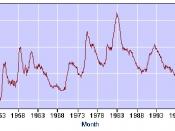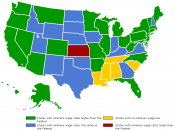If a person were to ask any worker if he or she would like a raise, the response would be a resounding yes. However, if one were to ask that same worker if he or she would like to be fired or have their hours of work reduced, then that worker would likely say no. The effects of minimum wage are centered on exactly these points. Minimum wage should be eliminated.
The federal minimum wage was instituted in 1938 as a provision of the Fair Labor Standards Act (FLSA). It was originally set at $0.25 per hour, about 40 percent of the average manufacturing wage at that time. Over the next forty years, the legal minimum was raised periodically, roughly in accord with the movement of market wages throughout the economy. Typically, its level has averaged between 40 percent and 50 percent of average manufacturing wages. In response to the high inflation of the late 1970's, the minimum wage was hiked seven times between 1974 and 1981, reaching $3.35
per hour, which was about 42 percent of manufacturing wages. Ronald Reagan vowed to keep a lid on the minimum wage, and by the time he stepped down as President, the minimum's unchanged level left it at 31 percent of average wages. Legislation passed in 1989 raised the minimum to $3.80 in 1990 and $4.25 in 1991. Five years later, at the urging of President Clinton, Congress raised it in two steps to $5.15 per hour ("History of Changes" 1). The minimum wage has been and still is enforced by the Wage and Hour Division of the U.S. Department of Labor ("Questions and Answers" 2).
A poll conducted by NBC-Wall Street Journal in December of 1994 showed that "73 percent of the American public favored a minimum wage increase, and 20...



Good argument
While I do not completely agree with your POV, this is a well researched and organized essay. Lots of stats in just the right places. @#%#$% AWESOME! Keep it up.
0 out of 0 people found this comment useful.